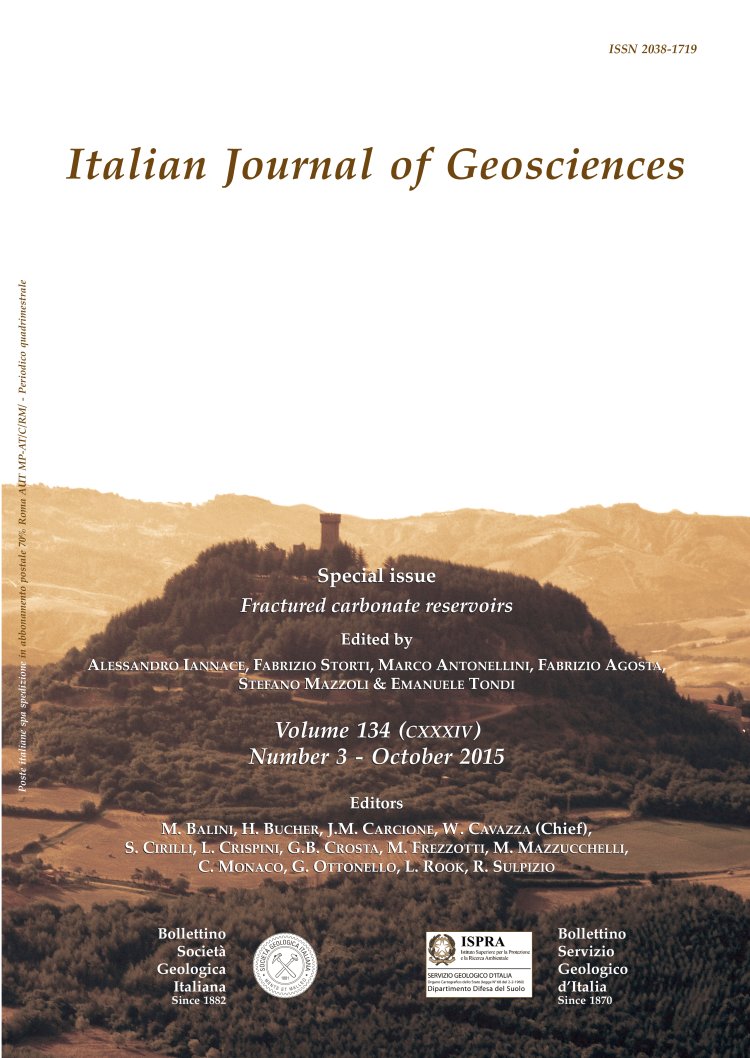
Background fractures in carbonates: inference on control of sedimentary facies, diagenesis and petrophysics on rock mechanical behavior. Example of the Murge Plateau (southern Italy)
Arthur P.C. Lavenu (*), Juliette Lamarche (**), Lisa Texier (**), Lionel Marié (**) & Bertrand D.M. Gauthier (***)
(*) ADMA-OPCO, PO box 303, Abu Dhabi, UAE. Corresponding author e-mail: alavenu@adma.ae
(**) Aix-Marseille Univ., CEREGE UM 34, 3 place Victor Hugo (case 67) - 13331 Marseille Cedex 3, France.
(***) Total EP, Tour Coupole, 2 place Jean Millier, La Défense 6, 92078 Paris-La Défense Cedex, France.
DOI: https://doi.org/10.3301/IJG.2014.58
Volume: 134 (2015) f.3
Pages: 535-555
Abstract
Characterizing fracture networks in Naturally Fractured Reservoirs (NFR) is a major challenge for hydrocarbon exploration and production. The fracture organization is: i) a key parameter for fluid flow understanding in carbonates (in a general sense) and ii) the key parameter in tight, non-porous carbonates. However, at present-day, the fracture parameters from subsurface data are not sufficient to define the 3D distribution of a fracture network. Moreover, in carbonate reservoirs, fracture occurrence strongly depends on the mechanical properties of the host rock such that characterizing fractures is only possible through the close study of the host rock heterogeneities. Studying fractures in outcrop analogues allows accessing to 3D fracture patterns, determining the host rock mechanical properties and their impact on fracture distribution. In this paper, we trace the conditions for the fracturing process through the geodynamic history of the reservoir. We aim at determining the sedimentary and diagenetic controls on fracture patterns and the genetic correlation with tectonic and burial history.
To this purpose, we have targeted two formations made of platform carbonates from the Murge Plateau. We analyzed the fracture patterns and sedimentary facies as well as the tectonic, diagenetic and burial history for each studied site. Fracture patterns are characterized from geometrical, kinematic and diagenetic criteria based on field and laboratory measurements. Fracture sequences are defined based on cross-cutting and abutting relationships and compared with geodynamic history.
Fractures are bed-perpendicular joints and veins, and numerous bed-parallel stylolites. We observe a stage of fracturing synchronous with shallow burial and prior to major tectonic events. Carbonates have undergone early diagenesis during fast and shallow burial, conferring early brittle behavior. Fracture development, mechanical and petrophysical properties are acquired during early burial.
To this purpose, we have targeted two formations made of platform carbonates from the Murge Plateau. We analyzed the fracture patterns and sedimentary facies as well as the tectonic, diagenetic and burial history for each studied site. Fracture patterns are characterized from geometrical, kinematic and diagenetic criteria based on field and laboratory measurements. Fracture sequences are defined based on cross-cutting and abutting relationships and compared with geodynamic history.
Fractures are bed-perpendicular joints and veins, and numerous bed-parallel stylolites. We observe a stage of fracturing synchronous with shallow burial and prior to major tectonic events. Carbonates have undergone early diagenesis during fast and shallow burial, conferring early brittle behavior. Fracture development, mechanical and petrophysical properties are acquired during early burial.
Keywords
Get Full Text